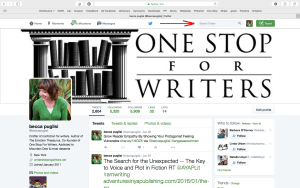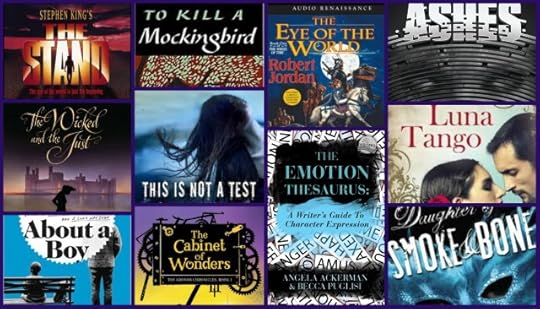Angela Ackerman's Blog: Writers Helping Writers, page 138
February 27, 2016
Emotional Wounds Thesaurus Entry: Being Raised by Neglectful Parents
When you’re writing a character, it’s important to know why she is the way she is. Knowing her backstory is important to achieving this end, and one of the most impactful pieces of a character’s backstory is her emotional wound. This negative experience from the past is so intense that a character will go to great lengths to avoid experiencing that kind of pain and negative emotion again. As a result, certain behaviors, beliefs, and character traits will emerge.
Characters, like real people, are unique, and will respond to wounding events differently. The vast array of possible emotional wounds combined with each character’s personality gives you many options in terms of how your character will turn out. With the right amount of exploration, you should be able to come up with a character whose past appropriately affects her present, resulting in a realistic character that will ring true with readers. Understanding what wounds a protagonist bears will also help you plot out her arc, creating a compelling journey of change that will satisfy readers.
NOTE: We realize that sometimes a wound we profile may have personal meaning, stirring up the past for some of our readers. It is not our intent to create emotional turmoil. Please know that we research each wounding topic carefully to treat it with the utmost respect.

Courtesy: Pixabay
Examples: Neglect can best be described as a caregiver’s ongoing failure to provide for a child’s basic needs. It comes in many forms, including physical, emotional, mental and medical neglect. Child or teen victims of neglect could be said to have been raised by parents who
refused to take their child to routine medical check-ups
were unable or unwilling to buy appropriate clothing for their child
often failed to feed their child
didn’t make their child go to school
withheld love and affection from the child
knew about and didn’t stop their child from engaging in dangerous behavior, such as abusing drugs or alcohol
left their child alone for long periods of time
often left their child alone
were neglectful due to their addictions
were neglectful due to mental illness
were so absorbed in their own lives, they neglected the basic care of their child
were unintentionally neglectful due to having to work multiple jobs
Basic Needs Often Compromised By This Wound: physiological needs, safety and security, love and belonging, esteem and recognition, self-actualization
False Beliefs That May Be Embraced As a Result of This Wound:
I am unlovable.
I’ve done something to deserve this treatment.
It’s my fault that I’m treated this way.
My life will always be this way.
I can’t depend on others for my survival; I have to fend for myself.
Adults can’t be trusted.
My parents’ love must be earned in some way.
This is what love looks like.
Positive Attributes That May Result: adaptable, ambitious, focused, independent, industrious, mature, nurturing, private, resourceful, responsible, simple, thrifty
Negative Traits That May Result: addictive, antisocial, apathetic, callous, compulsive, controlling, cruel, cynical, devious, dishonest, disrespectful, evasive, hostile, humorless, ignorant, impulsive, inattentive, inhibited, insecure, needy, nervous, pessimistic, rebellious, reckless, resentful, self-destructive, stingy, temperamental, timid, uncommunicative, uncooperative, violent, withdrawn
Resulting Fears:
Fear of repeating a parent’s mistakes with one’s own children
Fear of never being loved or accepted by anyone
Fear of being hungry/not having enough to eat
Fear of never being able to rise above one’s circumstances
Possible Habits That May Emerge:
Hoarding materials (food, clothing, toys, etc.)
Clinging to anyone who shows love and affection
Difficulty forming attachments to others, including one’s spouse and children
Struggling to parent effectively
Begging for or stealing the items one lacks
Seeing oneself as inadequate or insufficient in some way
Self-destructive behaviors (abusing drugs or alcohol, self-harming, engaging in risky sexual activity)
Sacrificing secondary needs to attain the ones that are most imperative (sacrificing safety to gain food or shelter, sacrificing self-actualization to gain someone’s love or affection). For more on this, see Maslow’s Hierarchy of Needs
Turning to a life of crime
Developing mental disorders (depression, PTSD, eating disorders, etc.)
Difficulties focusing or achieving in school
Resisting being responsible for others
Becoming determined to rise above one’s circumstances
Applying oneself to an activity, hobby, or interest as a means of escape
Becoming self-reliant
TIP: If you need help understanding the impact of these factors, please read our introductory post on the Emotional Wound Thesaurus. For our current list of Emotional Wound Entries, go here.
For other Descriptive Thesaurus Collections, go here.
The post Emotional Wounds Thesaurus Entry: Being Raised by Neglectful Parents appeared first on WRITERS HELPING WRITERS™.
February 24, 2016
Getting the Pacing Right

Courtesy: Jeremy Segrott @ Creative Commons
I’d like to start this post by stating an opinion that I think pretty much everyone shares: Pacing Sucks. When you get it right, no one really notices. I mean, how many times have you read a 5-star review that went on and on about the awesome pacing? On the other hand, when the pacing’s off, it’s obvious, but not always easy to pinpoint; you’re just left with this vague, ghostly feeling of dissatisfaction. One thing, though, is certain: if the pacing is wrong, it’s definitely going to bother your readers, so I thought I’d share some tips on how to keep the pace smooth and balanced.
1. Current Story vs. Backstory. Every character and every story has backstory. But the relaying of this information almost always slows the pace because it pulls the reader out of the current story and plops them into another one. It’s disorienting. And yet, a certain amount of backstory is necessary to create depth in regards to characters and plot. To keep the pace moving, only share what’s necessary for the reader to know at that moment. Dole out the history in small pieces within the context of the current story, and avoid narrative stretches that interrupt what’s going on. Here’s a great example from Above, by Leah Bobet:
The only good thing about my Curse is that I can still Pass. And that’s half enough to keep me out of trouble. But tonight it’s not the half I need because here’s Atticus, spindly crab arms folded ‘cross his chest, waiting outside my door. His eyes glow dim-shot amber—not bright, so he’s not mad, just annoyed and looking to be mad.
Bobet could have taken a lengthy paragraph to explain that certain people in this world have curses that are really mutations, that Atticus has crab claws for hands and his eyes glow when he gets angry. But that would’ve slowed the pace and been boring. Instead, Bobet wove this information into the current story—showed Atticus leaning against the door, showed his crustacean claws and his freaky, glowing eyes so the reader knows that he’s a mutant and, to the narrator, at least, this is normal. This is an excellent example of the artful weaving of backstory into the present story.
2. Action vs. Exposition/Internal Dialogue. Action is an accelerant. It keeps the pace from dragging. Granted, there will be places in your story that are inherently passive, where characters have to talk, or someone needs to think things out. The key is to break up these places with movement or activity. Characters should be in motion—smacking gum or doodling or fidgeting— while talking. Give them something to do during their thoughtful moments, whether it’s peeling carrots or painting a picture. These bits of action are like an optical illusion, fooling the reader into thinking something’s happening, when really, nothing’s going on. This is one scenario when readers actually prefer to be fooled, so make sure to energize those narrative stretches with action.

Because a nap is a good nap, no matter where it happens
3. Conflict vs. Downtime. On the flip side, you can’t have a story that’s all go and no stop. One might think that since action is good, more action is better. Not true. Readers need time to catch their breath, to recover from highly emotional or stressful scenes. A good pace is one that ebbs and flows—high action, a bit of recovery, then back to the activity again. Even The Maze Runner, possibly the most active novel I’ve ever read, has its moments of calm. When it comes to conflict and downtime, a definite balance is needed for the reader to feel satisfied.
4. Keep Upping the Stakes. We know that conflict is important—so important that every single scene needs it. But for conflict to be effective, it needs to escalate over the course of the story. To keep the reader engaged, each of the major conflict points needs to be bigger, more dramatic, and with stakes that are more desperate. This is exemplified in Ruta Sepetys’ excellent Between Shades of Gray, a historical fiction novel about the deportation of a Lithuanian family during World War II. It starts out ominous enough, with the family being forced from their home. Over the course of the story, they’re moved by cattle car across the continent, relocated to a forced labor camp, and eventually reach their final destination—a camp in the Arctic Circle where they’re expected to survive the elements with whatever resources they can scrounge. Clearly, lots of other conflict is interspersed, but when it comes to the major points, each one should have greater impact than the last.
5. Condense the timeline. When possible, keep your timeline tight. If it gets too spread out, the story will inevitably drag. It’s also hard, in a story that covers a long span, to keep things smooth; there will be time jumps of weeks or months or even years between scenes. Too many of these give the story a jerky feel. So when it comes to the timeline, condense it as much as possible to keep the pace steady.
For sure, pacing is tricky, but I’ve found these nuggets to be helpful in maintaining a good balance. What other tips do you have for keeping your story moving at the right pace?
SIDEBAR: A second post accidentally went out today for the monthly Critiques 4 U contest; that one wasn’t supposed to post today, so it’s been deleted. If you’re looking for that one, I apologize for the confusion!
The post Getting the Pacing Right appeared first on WRITERS HELPING WRITERS™.
February 20, 2016
Emotional Wound Thesaurus: Growing Up In The Public Eye
When you’re writing a character, it’s important to know why she is the way she is. Knowing her backstory is important to achieving this end, and one of the most impactful pieces of a character’s backstory is her emotional wound. This negative experience from the past is so intense that a character will go to great lengths to avoid experiencing that kind of pain and negative emotion again. As a result, certain behaviors, beliefs, and character traits will emerge.
 Characters, like real people, are unique, and will respond to wounding events differently. The vast array of possible emotional wounds combined with each character’s personality gives you many options in terms of how your character will turn out. With the right amount of exploration, you should be able to come up with a character whose past appropriately affects her present, resulting in a realistic character that will ring true with readers. Understanding what wounds a protagonist bears will also help you plot out her arc, creating a compelling journey of change that will satisfy readers.
Characters, like real people, are unique, and will respond to wounding events differently. The vast array of possible emotional wounds combined with each character’s personality gives you many options in terms of how your character will turn out. With the right amount of exploration, you should be able to come up with a character whose past appropriately affects her present, resulting in a realistic character that will ring true with readers. Understanding what wounds a protagonist bears will also help you plot out her arc, creating a compelling journey of change that will satisfy readers.
NOTE: We realize that sometimes a wound we profile may have personal meaning, stirring up the past for some of our readers. It is not our intent to create emotional turmoil. Please know that we research each wounding topic carefully to treat it with the utmost respect.
GROWING UP IN THE PUBLIC EYE
Examples:
Parents who have extreme wealth (own an airline, a hotel or fast food chain, etc.)
Parents who are important and well-connected (head of government organizations, high ranking military officials, etc.)
A parent or parents who are famous (movie stars, music singer, etc.)
Coming from royalty
A family that is very old and powerful (aristocrats, coming from nobility, well-respected)
Parents who are notably accomplished (sport stars, mega star painters or authors)
Being famous oneself (a child singing prodigy, actor, beauty queen, etc.)
Being famous for an unusual talent (being able to talk to the dead, healing people, etc.)
Having an infamous parent (a serial killer dad, a terrorist bomber mom, etc.)
Being part of a political family (generations of senators, governors, diplomats, etc.)
Basic Needs Often Compromised By This Wound: physiological needs, safety and security, love and belonging, esteem and recognition, self-actualization
False Beliefs That May Be Embraced As a Result of This Wound:
I don’t know who I am, just what I am supposed to be
I can’t afford to make any mistakes
People are cruel and want me to fail because I am famous
I can’t trust people; they only want to use me for my fame
People expect me to be just like my famous (mother, father, etc. *this can be negative, not just positive, if infamy is involved)
It doesn’t matter what I do, people will only know me for X
The cards are stacked against me (if one’s “fame” is negative)
Without X, I am nothing
Positive Attributes That May Result: adaptable, cautious, cooperative, courteous, discreet, disciplined, extroverted, generous, hospitable, independent, introverted, kind, loyal, mature, meticulous, obedient, organized, patient, private, proactive, proper, responsible, sentimental, socially aware, sophisticated, supportive, talented, unselfish
Negative Traits That May Result: addictive, callous, cocky, compulsive, confrontational, cynical, defensive, evasive, extravagant, foolish, frivolous, fussy, haughty, hypocritical, impatient, insecure, irresponsible, lazy, materialistic, melodramatic, paranoid, pretentious, rebellious, reckless, self-destructive, self-indulgent, selfish, tactless, temperamental, timid, vain, volatile, whiny, workaholic
Resulting Fears:
fear of trusting the wrong person
fear of public embarrassment
fear of making a decision that will haunt one forever
fear of never measuring up
fear of letting people down
fear of taking risks
fear of being vulnerable (and being taken advantage of)
fear of being oneself (and therefore disappointing others)
fear of making mistakes
fear of letting people in (and being betrayed or hurt by them)
Possible Habits That May Emerge:
being obsessive about presentation (clothing, hair, behavior, fitting in)
holding back rather than taking risks (for fear of screwing up publicly)
acting more mature than others of one’s age (having to grow up fast in the limelight)
hoarding one’s privacy (because one gets little of it)
Keeping secrets or avoiding voicing one’s opinion
obsessing over one’s imperfections
being very hard on oneself
false bravado or pretending to be overly confident
having few genuine close friendships (difficulty letting people in)
turning into a “mean girl” or something similar to armor oneself against haters so people leave one alone
doing what one is told and not thinking for oneself out if habit
Engaging in anonymous activity to “feel like everyone else” (disguises, chat boards with a fake name, etc.)
using alcohol or drugs to loosen up and not feel so self-concious
working hard and not making time for oneself, trying to keep up with expectations
messy burnouts and meltdowns from the pressure
TIP: If you need help understanding the impact of these factors, please read our introductory post on the Emotional Wound Thesaurus. For our current list of Emotional Wound Entries, go here.
For other Descriptive Thesaurus Collections, go here.
Image: GLady @ Pixabay
The post Emotional Wound Thesaurus: Growing Up In The Public Eye appeared first on WRITERS HELPING WRITERS™.
February 16, 2016
Why Scripts Are Rejected: 10 Screenwriting Errors To Avoid
We’re going to throw something different into the mix today: a post about screenwriting mistakes. This is an important post for all writers to read, including novelists, because the same advice can easily be translated to your fiction stories as you set out on the query trail.
For those who know us well and have read our books, especially The Positive Trait and Negative Trait Thesaurus books, you know we are huge supporters of writers learning from screenwriters and screenwriting structure techniques. One of our favorite instructors is Michael Hauge in fact, so much so that we’re bringing on a Story Structure tool that incorporates the 6-Stage structure model over at One Stop For Writers. (You can find out more about that incredible bit of news [and sneak-a-peek at what it looks like] HERE.)
All right, time to hand things over to our guest today, Norman Arvidsson. Please read on!
“The Play’s the Thing” – Unless You are Committing These 10 Errors
 90% of the scripts registered with the WGA are never completely read by script readers. They are rejected early on by readers who are overworked and pretty intolerant of basic errors that would-be screenwriters make. If you want to be in the 10% that get fully read and receive that call for further discussion, then don’t make these 10 fatal errors.
90% of the scripts registered with the WGA are never completely read by script readers. They are rejected early on by readers who are overworked and pretty intolerant of basic errors that would-be screenwriters make. If you want to be in the 10% that get fully read and receive that call for further discussion, then don’t make these 10 fatal errors.
Poor Development of the Main Character(s)
There are several potential goofs in the area of character development.
First, don’t write physical descriptions of your main character(s). You may have a picture in your mind of a character, but first readers don’t want that picture. They want to develop their own physical picture as they read the script. It can be irritating to a reader to have a physical description forced on them in the beginning.
Second, the character must face at least one issue that is big enough, even in comedies. If s/he does not, then there is no way the script can ever be translated into a full length play or movie.
Third, the character has to stay in character. Yes, events may change his/her mind about something, but the basic personality has to stay.
The way to avoid problems with consistency of character is to have your entire plot at least outlined before you begin to write page one. If you develop your plot as you go along, then you are trying to make your characters “fit” into a plot you are continually developing. It never works.
Poor Structure
If you are writing a script, it is assumed that you understand the components. You have to include each of those components in sequential order, and the readers has to be able to locate them as the script is reviewed. Of course, you know that you have to have an initial incident or conflict, followed by that initial turning point, the mid-point, a second turning point and then the climax and resolution. If you cannot identify these elements in your own script, something is wrong. The best way to avoid this is to have a storyboard before you begin to write. You are then able to label each plot section, know that your sequencing is correct, and see that each component is actually there.
Too Long/Too Short
One of the first things a script reader will look at is the length. These people know what you should know too. A script has to be between 90 – 140 pages. If it is too short, you have either left out important plot elements or truncated some of the scenes. If it’s too long, you have irrelevant content and scenes are too long. When scripts are not a reasonable length, the issue is usually poor structure. Return to your storyboard, take each section, read through that section of script and determine its “tightness.” If your script is too long, are you be-laboring dialogue by repeating a characters thoughts? If it is too short, do you need to develop an element further through more dialogue? The other possible problem, of course, is that the issue/conflict is not complex enough for a full-length script. Then you are back at square one.
Giving the Reader too Much Character and Scene Description
Script readers are very good with “filling in the blanks.” And they want to read something that lets them get their own mental pictures. So dump the long descriptions of the settings and characters. Descriptions should be minimal – just a couple of phrases. If you want excellent examples of this, pick up a copy of a Shakespearian play and read the descriptions at the beginning of the scenes.
Bad Writing (avoid writing mistakes)
Script readers are pretty much well-schooled in grammar, word usage, spelling and punctuation. They are happy to forgive a few typos, and of course there are grammatical and agreement errors in the dialogue of characters who are supposed to have them. But beyond that you really need to avoid writing mistakes. Script readers are easily irritated by these types of errors, and that irritation will carry over to their overall feeling about your work. If you struggle with grammar and composition, find someone who is more expert to edit your script.
Unoriginal Plot and/or Characters (Derivatives)
Of course you have your favorite authors and playwrights. We all do. But your love for a particular character or story line cannot carryover to your writing. Find inspiration for characters elsewhere – life is full of them. Use combinations of people you know or have known, unless, of course, your work is based upon some prominent real person. Script readers are looking for originality and they can pick up derivatives pretty quickly (so can an audience).
Tired Dialogue
What no one wants to read or hear is dialogue that is filled with tired and overworked phrases or clichés. It’s not fresh and original, and you work will be in the 90% rejection pile. As you write, flag those parts of dialogue that seem “tired” or worn and move on so you don’t disrupt your flow. You have time to think about fresh ways to say something later on. Go back to those flagged pieces when you are finished, get some ideas from other creatives you know, and freshen up those spots.
Characters Who “Tell”
The whole point of a screen play is to tell a story through the actions and dialogue of the characters. When a character says, “I am really angry with you” to another character, you are boring an audience. When characters say, “I love you” too much to each other, you are boring an audience. These things need to be shown not told. If you have a character who is angry, in love, in crisis, etc., go back and study movies or plays in which characters had these emotions and issues. Get some ideas about how to show them through dialogue and nonverbal behaviors.
Not Resolving Every Conflict/Issue
This is known as “fudging” and it does not work. If you have not resolved everything by the end of your script, do not submit it. You cannot just gloss over stuff and hope it is not detected. It will be detected, your story will not be complete, and your submission will be rejected. You have to wrap everything up and “tie a bow” on it. Go back to your storyboard. Find every conflict and issue. Then mark on that storyboard where it has been resolved. Resolution of all means you have a “tight” plot, and this is what script readers must see.
Format Issues
Don’t have your script rejected because you failed to follow proper format. If you don’t understand format for submissions, then get thee to a website that explains it or check with someone who is “in the know.” This is the easiest error of all to correct.
There are lots of reasons why scripts are rejected. Don’t count on a script reader to provide the details for why yours has been. S/he doesn’t know you personally and does not have the time to give feedback unless there is interest. Screenwriting is a creative art to be sure, but there is also a “science” involved. These 10 errors are part of that “science,” and they are critical.
 Norman Arvidsson is a freelance web developer with more than two years of experience behind him and also a contributing blogger.
Norman Arvidsson is a freelance web developer with more than two years of experience behind him and also a contributing blogger.
He is interested in web-design, web development, motivation, online education and personal growth. You can contact him through his Twitter, Facebook, Google+ or LinkedIn.
Have any questions about these 10 error to avoid? What would you add to the list? Let us know in the comments!
The post Why Scripts Are Rejected: 10 Screenwriting Errors To Avoid appeared first on WRITERS HELPING WRITERS™.
February 2, 2016
Twitter…for Research?
A long time ago, I wrote a children’s manuscript called Peculiar Plants. It was all about weird little shrubberies that did things that other plants don’t do. Most of them were rare, growing only in a small patch somewhere on the far side of the planet, so they were hard to research. And not being a botanist myself, I needed credible sources to vet my work and offer quotes. Back then, the Internet wasn’t what it is now, and it was really hard to find experts in the field, much less approach them with questions.
Luckily, the process is a lot easier now—if you know where to look. Kathy Klopp Cohen is here today to explain how, with just a few quick steps, one social media network can supply you with a whole list of experts in whatever field you need.
I opened a Twitter account some months back and had reservations about it. I already had Facebook, Goodreads, Amazon, and email accounts, so was it worth my while to also add Twitter to my day? In a very short period of time, I realized that YES, it was worth the time and effort—but not in the way I had expected.
While researching my new mystery, I ran into a dead end on one question: If investigators find a dog at a murder scene in someone’s house, what do they do with the dog? Nowhere on the Internet could I find out what would be done in this scenario. I employed Google, Facebook, and emailed friends but came up with nothing. Then I thought of Twitter.
I got on my account, searched for someone listed as a policeman/woman, and found one in my old hometown who seemed to be fairly active on Twitter—in other words, he seemed to get on his account at least daily. So I tweeted my question to him.
Two minutes later I had my reply. Just like that! In TWO minutes, I was able to consult an expert in the field who gave me the answer I needed to write my scene authentically.
I’m sold on using Twitter now as a research tool. And since research is necessary for all authors, I’d like to share the process with you.
Let’s say that you’re looking for the answer to the following question: “When a surgeon is performing a long operation—for twelve hours or more—does he take breaks to eat, and if so, where and how?”
1. On your Twitter account homepage, go to the “Search Twitter” box at the top right. Enter surgeon there.
2. That search will take you to a page called Surgeon. Click on the search box, and a drop box will appear with a fairly long list. Click on the very last option that says “search all people for surgeon.”
 3. And voilà! You now have a long list of bona fide surgeons with Twitter accounts who can be approached to answer your question.
3. And voilà! You now have a long list of bona fide surgeons with Twitter accounts who can be approached to answer your question.
4. As with any potential source, it’s important to verify that your new contact is who he/she claims to be. As you search your list, take the time to read the individual biographies under their names. The information they provide should include their full names, the cities in which they live, and their places of employment. In addition they should include links directing you to credentialed web sites, along with contact numbers you can use to verify their authenticity. Read some of their back-and-forth tweets to get a feel for their knowledgeability in the subject area and their potential willingness to answer your questions.
5. Settle on a few that seem to Tweet fairly regularly, since you’ll need your questions to be answered in a timely manner. Then politely message or tweet them with your question.
6.When you get a response from someone, be sure to say, “Thank you!”
If you’ve been looking for answers to questions for your story, try Twitter. It’s very likely that you’ll find an expert who’s willing to answer not only your immediate queries but also any others that come up down the road.
 Kathy Klopp Cohen is the author of three mystery novels and several articles covering topics of linguistic interest. All of her writing has required research, and she’s very happy to share how Twitter has enlarged her research sources. She has lived in Omaha, Nebraska, Germany, and the Washington D.C. area and currently resides in Minneapolis, Minnesota. You can check out all of her published works at her Amazon author page.
Kathy Klopp Cohen is the author of three mystery novels and several articles covering topics of linguistic interest. All of her writing has required research, and she’s very happy to share how Twitter has enlarged her research sources. She has lived in Omaha, Nebraska, Germany, and the Washington D.C. area and currently resides in Minneapolis, Minnesota. You can check out all of her published works at her Amazon author page.
The post Twitter…for Research? appeared first on WRITERS HELPING WRITERS™.
January 30, 2016
Emotional Wounds Thesaurus Entry: Spending Time in Jail
When you’re writing a character, it’s important to know why she is the way she is. Knowing her backstory is important to achieving this end, and one of the most impactful pieces of a character’s backstory is her emotional wound. This negative experience from the past is so intense that a character will go to great lengths to avoid experiencing that kind of pain and negative emotion again. As a result, certain behaviors, beliefs, and character traits will emerge.
Characters, like real people, are unique, and will respond to wounding events differently. The vast array of possible emotional wounds combined with each character’s personality gives you many options in terms of how your character will turn out. With the right amount of exploration, you should be able to come up with a character whose past appropriately affects her present, resulting in a realistic character that will ring true with readers. Understanding what wounds a protagonist bears will also help you plot out her arc, creating a compelling journey of change that will satisfy readers.
NOTE: We realize that sometimes a wound we profile may have personal meaning, stirring up the past for some of our readers. It is not our intent to create emotional turmoil. Please know that we research each wounding topic carefully to treat it with the utmost respect.

Courtesy: Pixabay
Definition: Spending a considerable amount of time in jail due to a legitimate conviction, then being released. While being imprisoned for a crime one didn’t commit is a real wounding event, that event will be explored in a different entry. Today’s post is meant to explore the wounds caused by an imprisonment and how they might affect someone after incarceration.
Basic Needs Often Compromised By This Wound: safety and security, love and belonging, esteem and recognition, self-actualization
False Beliefs That May Be Embraced As a Result of This Wound:
I’m not safe; I always have to be looking over my shoulder.
People will only see me as a convict.
I’ll always be a screw-up.
No one will ever trust me.
I can’t succeed with this monkey on my back.
I’ll never be able to live a normal life.
I won’t be able to realize my dreams.
I’ve ruined any chance of reconciling with my loved ones.
Positive Attributes That May Result: alert, ambitious, appreciative, bold, cautious, discreet, easygoing, humble, independent, loyal, obedient, patient, pensive, persistent, private, protective, resourceful, simple, thrifty
Negative Traits That May Result: addictive, antisocial, callous, cocky, confrontational, cynical, defensive, devious, disrespectful, evasive, hostile, martyr, needy, nervous, paranoid, pessimistic, possessive, prejudiced, rebellious, resentful, self-destructive, subservient, timid, uncommunicative, volatile, weak-willed, withdrawn
Resulting Fears:
Fear of returning to jail
Fear of losing the few relatives or friends who believe in him
Fear of not being able to support oneself through legitimate means
Fear of falling back into the unhealthy habits that landed him in jail
Fear of younger loved ones (siblings, children, nieces, nephews) following in one’s footsteps
Fear of never finding love
Possible Habits That May Emerge:
Becoming a hard worker in an effort to prove oneself
Becoming lazy after being taken care of for so long
Hoarding belongings; being overly possessive of one’s things
Being content with little in the way of material things
Being grateful for things that others take for granted
Becoming serious about safety (being alert when walking after dark, adding security to one’s home, etc.)
Fearing the police and other security officials
Obeying blindly out of a desire to stay out of trouble
Rebelling against authority and the law
Not thinking for oneself
Withdrawing from others
Avoiding the places, people, and pastimes that were part of one’s life before jail
Falling into addiction as a coping mechanism
Drifting aimlessly without any clear goals
Sticking close to any family members or friends who reach out after jail
Trying to succeed on one’s own, without anyone’s help
Returning to criminal activity, either because one can’t support oneself legitimately or because the unsavory activities are habitual or safe
Never speaking about one’s jail experiences
Exaggerating one’s experiences to make oneself look good to others
Becoming socially active to effect change (regarding prison conditions, helping convicts to successfully re-enter society, etc.)
Avoiding family out of the belief that they want nothing to do with the incarcerated person or the fear of letting them down
TIP: If you need help understanding the impact of these factors, please read our introductory post on the Emotional Wound Thesaurus. For our current list of Emotional Wound Entries, go here.
For other Descriptive Thesaurus Collections, go here.
The post Emotional Wounds Thesaurus Entry: Spending Time in Jail appeared first on WRITERS HELPING WRITERS™.
January 26, 2016
Grow Reader Empathy By Showing Your Protagonist’s Vulnerable Side
As writers, we all want to encourage a powerful bond to form between our audience and the protagonist so that readers care about the hero or heroine and root for them to succeed. How we do this is through empathy, which is a feeling of understanding and connection that comes about when we successfully put the reader into the character’s emotional shoes.
The Power of Vulnerability
 Vulnerability is a necessary element to building empathy, but like all powerful things, it is a blade with two sides. On one hand, as people, we connect to displays of vulnerability because it gives us a glimpse at what lies beneath the mask a person wears day-to-day. When someone reveals a truth, an emotion, a deep belief or their biggest fear, they expose their heart to someone else. The willingness to be vulnerable (a necessary ingredient for love and intimacy, for example) is about saying, “this is who I am. I am sharing this real self with you.” It is self-acceptance and courage at the highest level, the purest form.
Vulnerability is a necessary element to building empathy, but like all powerful things, it is a blade with two sides. On one hand, as people, we connect to displays of vulnerability because it gives us a glimpse at what lies beneath the mask a person wears day-to-day. When someone reveals a truth, an emotion, a deep belief or their biggest fear, they expose their heart to someone else. The willingness to be vulnerable (a necessary ingredient for love and intimacy, for example) is about saying, “this is who I am. I am sharing this real self with you.” It is self-acceptance and courage at the highest level, the purest form.
But vulnerability means being open, and that means risk. We’re going out on a limb, opening ourselves to whatever comes. Pain. Emotional wounds. Judgement, blame, criticism, rejection, humiliation, exploitation, and a host of other things no one wants to feel. This is why it is human nature for people to try to avoid feeling vulnerable and to act strong, even when we are not.
To create credible characters, we want to mirror the real world. This means that like real people, most characters will resist showing their vulnerable side, too.
Do you see the conundrum here? We need to show readers our character’s vulnerable side to help empathy form, but as mirrors of real people, the character will fight us, refusing to let down their guard and acknowledge their soft spots. What a head trip, right? Here we thought we authors were in charge, but nope.
Luckily, authors tend to be, er, sneaky. (Okay, okay, manipulative.)
When our characters are being all alpha tough and refusing to let people in, we can turn once again to the real world for help. Some situations just make a person feel vulnerable. There’s no choice. So, if we identify “universal triggers” for vulnerability, it won’t matter how stubborn our characters are. Simply by deploying a trigger, we’ll be able to place them in a situation that leaves them feeling exposed.
Through their actions, their thoughts and by making them look within at their greatest fears, readers will see a POV character’s soft side. Better still, because these are real world events, readers themselves will know exactly how the situation can lead to that feeling of vulnerability.
Here are some ways to make your character feel – and appear – vulnerable, whether they want to or not.
Through not knowing what will happen next.
 People crave control, of having power over what the future will bring. Take that away and you are left with the feeling of not knowing, of having no influence or say in the outcome. By placing the power in another’s hands through choices, actions and decisions, you rob your character of control. The resulting feelings of frustration, anxiety and even despair are all ones that reinforce vulnerability. Readers have all felt a loss of control at some point and so will deeply identify with the character’s range of feelings.
People crave control, of having power over what the future will bring. Take that away and you are left with the feeling of not knowing, of having no influence or say in the outcome. By placing the power in another’s hands through choices, actions and decisions, you rob your character of control. The resulting feelings of frustration, anxiety and even despair are all ones that reinforce vulnerability. Readers have all felt a loss of control at some point and so will deeply identify with the character’s range of feelings.
Through the mistakes they make.
Despite our best efforts, we all make mistakes. Not only do we hate it when one happens, we tend to beat ourselves up about it, growing frustrated and disappointed for not being smarter, stronger or better. Characters who make mistakes feel authentic, and it humanizes them to readers. Besides, mistakes create great plot complications & conflict!
Through personal failures.
Not succeeding at what one has set out to do is one of the most heartbreaking moments an individual can experience, and it is the same for our characters. A hero’s personal failure, especially one that has repercussions for others, is one way to break down those steel walls and show our hero as vulnerable and human.
Through a death or loss.
A deep, personal loss is never easy. Often a person only realizes what they had or what something meant when it’s gone. Again, this is a universal feeling, something all readers can identify with. Written well, seeing the hero experience loss will remind readers of their own past experiences. Death is final, but other losses can be potent as well. The loss of hope is particularly wounding.
By having one’s role challenged.
Whatever the character’s role is (be it a leader, a provider, a source of comfort , etc.), having it challenged can be devastating. Roles are tied to one’s identity: the husband who loses his job may no longer be able to provide for his family. The leader who made a bad decision must witness the resulting lack of faith from his followers. The mother who fails to keep her child safe feels unsuited for motherhood. When a role is challenged in some way through choices or circumstances, it creates self-doubt, making the character feel vulnerable in a way readers identify with.
By casting doubt on what one believes.
Each person has set beliefs about the universe, how the world works, and the people in it, allowing them to understand their place in the big picture and instilling feelings of belonging. When knowledge surfaces that puts trusted beliefs into question, the character suffers disillusionment, a powerful feeling that can make them feel adrift in their own life.
Disillusionment is an emotional blow and everyone has suffered one at some point. This can be a good way to trigger that feeling of shared experience of vulnerability between character and reader.
By experiencing fear or worry for another.
This ties into that loss of control I mentioned above, because one directly or indirectly has a lack of influence over circumstances affecting a loved one. Fear and worry can also create road blocks about how best to proceed. It’s one thing to take risks that only affect oneself, and another to take risks that will impact others. The paralysis a person feels over what decision to make when it impacts relationships is an experience readers understand.
By having one’s secrets brought out in the open.
Secrets are usually hidden for a reason and are often the source of guilt or shame. When one’s secrets are revealed, the character is stripped of their security, and they believe others will view them differently as a result. Readers can empathize with this raw feeling of being exposed. (This link has lots more information about secrets.)
![Pageflex Persona [document: PRS0000046_00058]](https://i.gr-assets.com/images/S/compressed.photo.goodreads.com/hostedimages/1444438238i/16500206.jpg) Showing vulnerability is all about emotion, so if you have it, pull out your Emotion Thesaurus the next time you want to find a unique way to show, not tell, that feeling of being exposed.
Showing vulnerability is all about emotion, so if you have it, pull out your Emotion Thesaurus the next time you want to find a unique way to show, not tell, that feeling of being exposed.
As you can see, there are many other ways to bring out a character’s vulnerable side. What techniques do you use on your cast of characters?
Image 1: Foundry @ Pixabay
Image 2: RossandZane @ Pixabay
The post Grow Reader Empathy By Showing Your Protagonist’s Vulnerable Side appeared first on WRITERS HELPING WRITERS™.
January 21, 2016
Blogging, Marketing & Social Media: Three Rules I Break & Why
This is one of those posts that I hesitate to write, simply because there is a whole lot of “You should do X & must do Y” advice that, er, Becca and I do not do. Maybe this costs us sometimes, but it’s what works for us. So, I’m going to pull the curtain back a bit and offer some food for thought.
Before we move on…
There’s no judgements here on what other people do. This is about what Becca & I do. I will try to give my reasons for the choices we’ve made. Mileage may vary.
Monetizing Our Blog
 You will notice there are no ads here, no requests for donations, no “tip jar” set up. Have people expressed a desire to tip? Yes. Could we make money with ads based on traffic? You bet. Have people offered to pay us for ad space? Many times. But honestly, Becca and I feel everyone gets enough BUY, BUY, BUY elsewhere, and we don’t want Writers Helping Writers to be bulked up with Google Ads and the like.
You will notice there are no ads here, no requests for donations, no “tip jar” set up. Have people expressed a desire to tip? Yes. Could we make money with ads based on traffic? You bet. Have people offered to pay us for ad space? Many times. But honestly, Becca and I feel everyone gets enough BUY, BUY, BUY elsewhere, and we don’t want Writers Helping Writers to be bulked up with Google Ads and the like.
So, we’ve chosen not to monetize our blog beyond a few affiliate links to Amazon. If, down the road, we have a sidebar link to another site or service it’s because we believe in that site’s purpose, not because we’re being paid.
Are we leaving money on the table? Probably. But to us, your shares, referrals and word of mouth about our books, the Writers Helping Writers site, and now our One Stop For Writers library too…these are all the thanks we need.
If you want to support us and what we do, just tell a writing friend about us and our work. That helps so much. 
Thanking Everyone Who Tweets & Shares
 Okay, here’s the thing. Would I love to do this? Yes. And do I absolutely appreciate the time that everyone takes when they tweet me or share a link? Holy heck, yes! But the reality is that I get so many re-tweets now that to respond to them all I would literally be doing nothing each day but thanking people in tweets.
Okay, here’s the thing. Would I love to do this? Yes. And do I absolutely appreciate the time that everyone takes when they tweet me or share a link? Holy heck, yes! But the reality is that I get so many re-tweets now that to respond to them all I would literally be doing nothing each day but thanking people in tweets.
I know you guys love good writing content, and I try to find it, build it, and share it. I am betting that if asked, you’d say you’d rather me be doing that (and, you know, write more books) than spend that time thanking you for each tweet.
So, I made a judgement call and stick to an occasional “thank you all for the tweets” post. I respond to all conversation though, and always will. I hope you’re all okay with this and understand where I’m at, because I love you guys!
Use Free Incentives for Newsletter Sign Ups
It’s practically the Golden Rule: give something away for free to encourage people to sign up for a newsletter. And…it’s a rule I break, with good reason.
To me a newsletter should be personal, fun, entertaining or have high value. People should want to read it. You can give the best freebie in the world away, but if you don’t follow through with a newsletter that keeps their interest, not only will they unsubscribe right away anyway, their disappointment will probably cause them to hesitate when you do have a book or product for sale.
 The other reason is because I see people misuse freebies all the time. Even the big marketing gurus who offer free courses or webinars can go too far with the hard sell. I’ve attended more than a few webinars on how to market better, increase newsletter sign ups, build a sales funnel, etc. only to see the same manipulative techniques they teach being deployed in their follow up emails, all in hopes of “up-selling” a coaching service they provide.
The other reason is because I see people misuse freebies all the time. Even the big marketing gurus who offer free courses or webinars can go too far with the hard sell. I’ve attended more than a few webinars on how to market better, increase newsletter sign ups, build a sales funnel, etc. only to see the same manipulative techniques they teach being deployed in their follow up emails, all in hopes of “up-selling” a coaching service they provide.
Look, I get marketing. After all, girl gotta eat. Becca and I & our collective families? Yep, we gotta eat. So Coaching Gurus, well, they gotta eat too.
But when marketing is done poorly, it leaves a bad taste in my mouth. I don’t want anyone to feel that way because of something I do. I’d rather be transparent and just point you right to our Tools For Writers page, which is brimming with free, rather than make you do something to get free things.
(Really, visit and grab what you need. Becca and I like to share this stuff because we believe we should all grow and succeed together.)
When it comes to newsletters, I still have a lot to learn. I’m working hard to create ones that give my readers what the need and want. But I’d rather spend time growing my skills and focus on the content than try and entice people to sign up with the lure of “free.”
And here’s the thing…even without freebies, I average about 100 or so new sign ups between newsletters. So I really think it’s about the content, not the sign up bonus. So if you want to offer the free item on sign up, go for it. But make sure your focus is KEEPING subscribers, not just getting them to add their email.
(By the way, I love every one of our subscribers and their willingness to follow my lunatic ravings er, rambles!)
That’s my three. What rules do you break and why? Let me know in the comments!
Image 1: Mdgrafik0 @ Pixabay
Image2: Ryan McGuire @Pixabay
Image3: Model4you @ Pixabay
The post Blogging, Marketing & Social Media: Three Rules I Break & Why appeared first on WRITERS HELPING WRITERS™.
January 19, 2016
Critiques 4 U, January Style

Courtesy: Pixabay
Happy New Year, everyone! I tell you, 2015 was a CR-AZY year for me, between the launch of One Stop For Writers and moving my family across the country. I’d kind of like to see it calm down a bit, but calm doesn’t seem to be in my cards. And I guess that’s ok, because the only way we’re going to improve and grow and achieve awesome things is by challenging ourselves and getting outside of our comfort zones. If you’re up for a bit of challenge yourself, let me tell you what’s happening with this month’s Critiques 4 U contest.
Last week, I posted about the importance of log lines and challenged you to write one for your story. I hope you were able to come up with something interesting, because I’ll be choosing today’s first-page critique winners based on those log lines. If you didn’t get a chance to write one up, don’t worry. I’ve extended this month’s contest to two days rather than the usual one, to give you some extra time.
To enter, just leave a comment with…
the log line for your story. Make sure that it contains the three elements mentioned in last week’s post: protagonist, goal, and stakes. If you have multiple stories and you’d like to leave a log line for each one, go for it, but please only enter one log line for each story.
your email address. Some of you have expressed concern about making your email address public; if you’re sure that the email address associated with your WordPress account is correct, you don’t have to include it here. But if you do win and I’m unable to contact you through that email address, I’ll have to choose an alternate winner.
And that’s it. The three log lines that intrigue me the most will win a first-page critique.
BUT WAIT! THERE’S MORE!
I know I’m asking more from you this week than usual, so it’s only fair that I offer a bit more in return. Along with a first-page critique, each winner will also receive a one-month subscription to One Stop For Writers! Holy buckets, folks. That’s a sweet deal. I honestly don’t know how many people will enter this month’s contest, so if you do enter, you might also have less competition than usual.
So get those log lines written and load ’em up. The contest ends Thursday morning, as soon as I can drag myself out of bed and close it out. Good luck!
The post Critiques 4 U, January Style appeared first on WRITERS HELPING WRITERS™.
January 16, 2016
1000 Reviews Winners & Our Charity of the Year
Ready to get to the winners? We are!
Congrats go to:
R.W. Foster, Amy Morris-Jones, Tom Wood, Celia Lewis, Dee Wilson, Nina Falkestav, Marcy Kennedy, Carolyn McBride, Sallie Yonce, Patrick Witz, Monique Loubert, Duane Wiley, & Lou W. Sytsma
Watch your mailbox, winners–I will be in touch! 
Also before we go, an introduction.
Each year, Becca and I donate to a charity of our choosing on behalf of Writers Helping Writers. To date, we’ve given $3500 to different worthy projects, so know that when you buy one of our books, you’re helping to pay-it-forward into the world. This year our chosen charity is Room to Read.
 This organization has two main focuses: literacy and gender equality in education. Their mission statement: We envision a world in which all children can pursue a quality education, reach their full potential and contribute to their community and the world.
This organization has two main focuses: literacy and gender equality in education. Their mission statement: We envision a world in which all children can pursue a quality education, reach their full potential and contribute to their community and the world.
Becca and I are so excited to be able to help this organization, and it’s only through your support that we’re able to do it. So THANK YOU!
And congrats again to all the winners. Happy writing, all.
The post 1000 Reviews Winners & Our Charity of the Year appeared first on WRITERS HELPING WRITERS™.
Writers Helping Writers
- Angela Ackerman's profile
- 1014 followers






